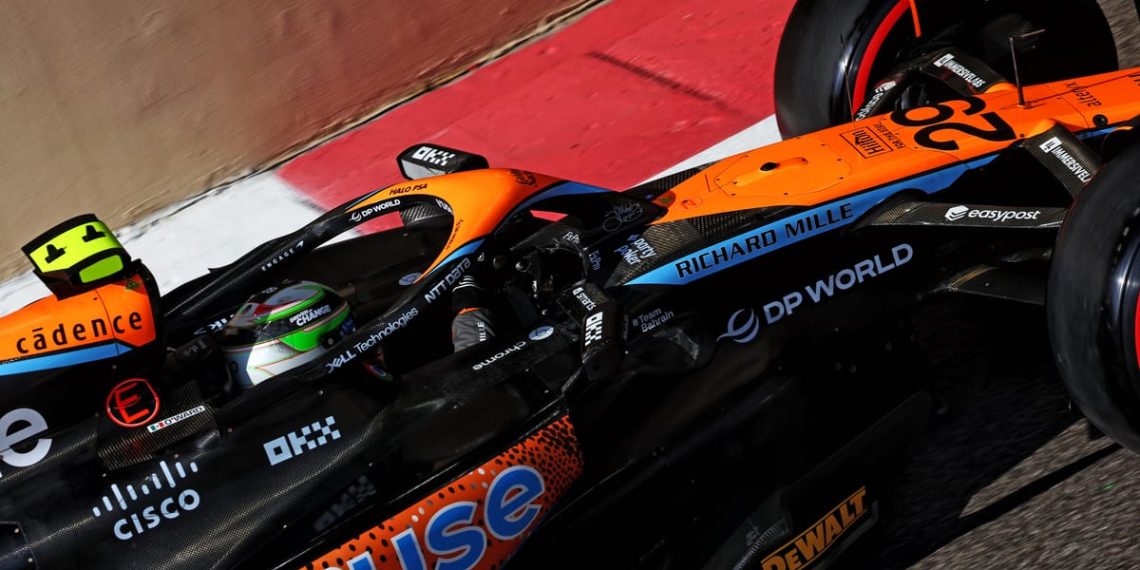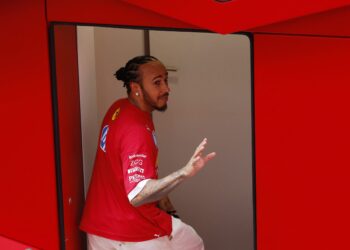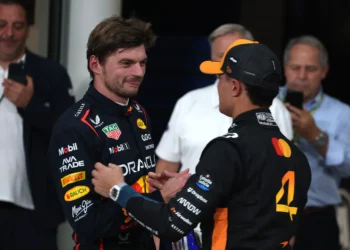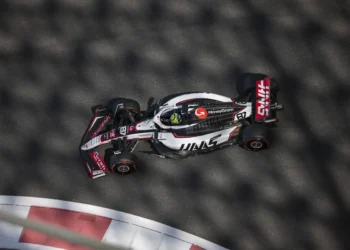Until the Autonomous Racing League of Abu Dhabi
“You could compete in Formula 1, right?”
“Any of us could, and we would do well.”
That was Josef Newgarden, the winner of the Indianapolis 500, responding to a question from former NFL kicker Pat McAfee on his popular TV show. Naturally, this clip caught the attention of both IndyCar and Formula 1 fans, reigniting the debate about whether IndyCar drivers have the potential to compete in F1. Andretti’s desire to bring Colton Herta to an F1 team, as well as the appearances of Alex Palou and Pato O’Ward with McLaren, have also brought this debate to the forefront.
Newgarden, who once had hopes of moving up the F1 ladder and has experience racing in GP3, enjoys engaging in this debate about IndyCar drivers transitioning to F1 and has expressed his thoughts on the matter in the past.
While he says “any of us,” he is probably referring to the championship leaders. In previous discussions, he strongly expressed why it is rare for an IndyCar driver to successfully transition to F1.
“You’re not going to get there through IndyCar unless there’s a very special circumstance,” Newgarden said. “You still need to integrate into their system, their people, their political structure, and you need to secure significant funding, which has become increasingly difficult.”
According to Newgarden, the pressure and challenges faced by young drivers aspiring to reach F1 have multiplied due to the limited number of seats and opportunities available.
In my assessment of Newgarden’s statement, it is clear that he is not referring to all drivers on the grid. Now, let’s examine the arguments that support his position, as well as those that contradict it, and explore the factors behind them.
Although we do not have an extensive set of data, if F1 is truly superior to IndyCar as many claim, why have drivers who mainly competed in the midfield of F1 not dominated when they made the transition to IndyCar? Additionally, it is worth noting that F1 drivers who have recently moved to IndyCar have not outperformed their IndyCar counterparts on street and road courses over a season.
Some argue that it would take a driver of the caliber of Lewis Hamilton or Max Verstappen to demonstrate how an F1 driver could dominate in IndyCar. However, even if we assume that the midfield of F1 is as strong as believed, drivers coming from that level should still be competitive at the front of the IndyCar grid.
There are several factors to consider. Established IndyCar drivers have knowledge of the tracks, tires, cars, and team dynamics that would pose the same challenges for IndyCar drivers transitioning to F1. However, we have not seen an F1 driver come in and dominate to the extent that raises doubts about an IndyCar driver’s ability to make the transition.
For example, Alex Palou was within three tenths of Lando Norris, a comparable F1 driver, during his debut in FP1 at the Circuit of the Americas in 2022. Although Pato O’Ward’s performance in Abu Dhabi last year was not as impressive, both drivers showed they were capable of competing at a level worthy of an opportunity in F1.
It is important to note that a single participation in FP1 and regular competition throughout races and qualifying are very different scenarios. However, their performances indicate that they deserve consideration based on their on-track performances.
Both IndyCar and F1 require specialized skills, making the perfect transition between the two challenging. Moving from IndyCar to F1 means going from a series that focuses on maximizing the performance of a fixed car to a series where constant updates make previous work obsolete. The cars themselves are also different, with IndyCars allowing for more aggressive driving, while F1 cars require a different approach.
Furthermore, F1 tracks, Pirelli tires, and limited availability of on-track data from teammates present additional challenges. In F1, drivers face more experienced opponents, further increasing the learning curve for those transitioning from IndyCar.
Newgarden himself faced difficulties during his time in GP3, and his lack of financial support made it nearly impossible to reach F1. Few current IndyCar drivers have attempted the same path, and those who have tried have not been successful. The high costs associated with racing in Europe have proven challenging for American drivers.
The growing trend of successful junior single-seater drivers opting for IndyCar instead of F1 indicates the difficulty of reaching F1, even for drivers who have met all expectations. F1 teams have numerous options to consider before thinking about hiring an IndyCar driver.
Although the IndyCar series has undergone significant changes in the last 12 years, the fundamental nature of the cars remains the same. In contrast, F1 cars undergo regular updates, making it challenging for IndyCar drivers to adapt to constant changes.
Although IndyCar drivers are often praised for their adaptability, the demands placed on F1 drivers are on another level. F1 requires drivers to quickly adjust to different styles and driving demands, which is a significant challenge.
While there are criticisms and competition in IndyCar, F1 operates at a different level of intensity and attention. The political landscape in F1 is relentless, and the level of preparation required to succeed is unparalleled. While there is some preparation for this in IndyCar, it is not at the same level as F1.
A switch to F1 would subject any driver to intense scrutiny and immense pressure. The spotlight in F1 is relentless, and the political landscape can make or break a career. The level of attention and demands in F1 is unmatched by any other racing series.
If an IndyCar driver were to transition to F1, who would be the most suitable candidate? Let’s examine the current grid and draw some conclusions.
Andretti has identified Herta as their preferred driver for their potential F1 team. Since entering the series in 2019, Herta has consistently been one of Andretti’s most promising talents, aside from a brief performance dip last year. He impressed McLaren during a test in 2022 and demonstrated the speed and qualifying skill required for success in F1. However, his inconsistency remains a concern.
O’Ward, who seems to have fallen behind Palou in McLaren’s preference order, has also proven to be a talented driver. However, the lack of a championship-winning car and a teammate of equal caliber make it difficult to assess his true potential. Additionally, his exciting driving style may not translate into the consistency and precision required in F1.
Palou showed his potential during his appearances in the 2022 FP1. However, his decision to violate his contract with McLaren and stay with Ganassi may raise concerns for potential teams. Despite his age, ability, and results, teams may hesitate to hire him based on his track record in the driver market.
Newgarden, despite his past success and strong attributes, may face challenges due to his age and recent drop in performance. However, his ability to handle pressure, lead a team, and his competitive spirit make him a formidable competitor.
In conclusion, the debate about IndyCar drivers transitioning to F1 continues to spark interest among fans. While there are factors supporting the idea that IndyCar drivers can succeed in F1, there are also significant challenges and differences between the two series that must be considered. Ultimately, the decision to transition from IndyCar to F1 would require a careful evaluation of each driver’s skills, experience, and potential for success.
© 2024
Brazilian driver, Pedro Silva, achieved an impressive victory in this Sunday’s Formula 1 Grand Prix. With a breathtaking display, Silva overtook his competitors and crossed the finish line in first place. This victory marks a historic moment for Brazil, as Silva becomes the first Brazilian driver to win a Grand Prix in over a decade.
The race started with an exciting start, with Silva coming from pole position. He maintained the lead from the start and showed incredible pace throughout the race. Even under pressure from rival drivers, Silva managed to stay ahead and secure the victory.
The victory of Silva is a great boost for the Brazilian Formula 1 team. With his exceptional performance, he has shown that the team has the potential to compete with the best teams in the world. This will certainly attract more sponsors and investments to the team, which will help in the development and growth of Brazilian motorsport.
Silva expressed his gratitude to the team and Brazilian fans after the race. He dedicated the victory to everyone who has supported him throughout his career and promised to continue working hard to achieve more success.
The next race of the Formula 1 season will be held next month. With Silva’s victory, expectations are high for the Brazilian team. It will be interesting to see if they can maintain the momentum and continue competing at the top.
This victory is a reminder that Brazil has talent and potential in motorsport. With more investments and support, the country can produce more standout drivers and achieve more victories on the international stage. The future of Brazilian motorsport looks promising, and Silva is a shining example of that.










